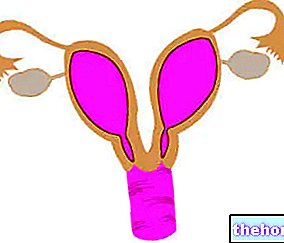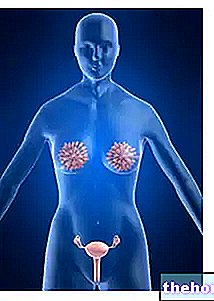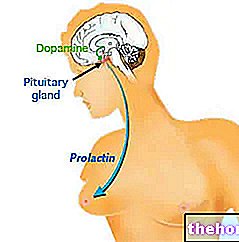Generality
Fibrocystic mastopathy is a "benign breast disease that affects many women of childbearing age.
This condition is characterized by the presence of fibrous areas in the breast tissue and by the appearance of nodules and cysts of various sizes, which can also be appreciated on palpation of the breast.

In most cases, no treatment is needed; the manifestations associated with the affection tend to decrease, in fact, after the menopause.
Although it is a benign condition that does not normally evolve towards malignancy, fibrocystic mastopathy still makes clinical monitoring appropriate, possibly associated with complementary investigations (radiological examinations, ultrasound, mammography and biopsy).
Furthermore, it is a good habit to regularly practice breast self-examination, a method which is not in itself diagnostic, but which is able to indicate, in an early period, any changes with respect to the basic picture.
Causes
Fibrocystic mastopathy is a mammary dysplasia, that is a "benign alteration of the breast tissues. This condition occurs mainly in the fertile period, between 30 and 50 years, but can also affect younger women and can be present even after menopause. , especially if hormone replacement therapy is used.
The causes of fibrocystic mastopathy are still not fully understood. However, it is known that the development of this form of dysplasia is closely related to changes in the hormonal balance (eg alteration of the estrogen-progestin ratio, excess estrogen, etc.) and to the cyclical changes that usually take place in the gland breast in the different phases of the menstrual cycle.
Some scientific sources consider fibrocystic mastopathy a "paraphysiological" condition (ie almost normal, in some respects); in fact, the manifestations of fibrocystic mastopathy tend to decrease after menopause.
Often, women who have breasts with a rich glandular component are more prone to this problem. L
and the likelihood of developing fibrocystic mastopathy is also higher if no pregnancies have ever been undertaken and when the family history for the disorder is positive.
Women who, during their fertile life, have undergone repeated irregularities in menstrual cycles may also be predisposed to this form of breast dysplasia.
Symptoms
From a clinical point of view, fibrocystic mastopathy is characterized by the presence of fibrous areas, cysts with liquid content, solid nodules and irregular proliferation of the ducts and glandular epithelium; these changes in the breast tissue occur in isolation or can be variously associated.
The lesions of fibrocystic mastopathy are more or less numerous and usually involve both breasts.
During breast self-examination, agglomerations of various sizes (from a few millimeters to a few centimeters) or well-defined masses can be found, mobile in the context of the breast tissue and without signs of skin retraction.
Around the time of menstruation, the nodular and cystic areas tend to increase in volume due to hormonal fluctuations.
Fibrocystic mastopathy can also cause hypersensitivity, pain (mastodynia) and a sense of tension, particularly in the upper quadrant of the breast. Generally, these symptoms increase in intensity before the onset of menstruation and tend to progressively reduce after the onset of the flow.
The tenderness can also be felt when the breasts are compressed in some way, for example during sleep or physical activity. Sometimes, the painful symptoms can also extend to the arm.
Does fibrocystic mastopathy increase the risk of breast cancer?
Many scientific studies have shown that fibrocystic mastopathy does not represent a preneoplastic condition, therefore it does not constitute a risk factor, nor does it increase the chances of developing breast cancer.
However, a moderately increased risk of developing breast cancer may be determined by the presence of an atypical "epithelial hyperplasia, an alteration that causes subjective symptoms and palpatory changes that are not easily distinguishable from those of fibrocystic mastopathy. From the histological point of view, this picture is characterized by an excess growth of epithelial cells of the mammary gland, some of which have an abnormal structure, which can potentially evolve, over time, in a malignant sense.
Therefore, if an atypical epithelial proliferation is found during a histological examination, performed for any reason, regular clinical and mammographic monitoring of the patient is indicated.
Diagnosis
Considering that the benign or malignant characteristics of a breast lump are not easy to distinguish, it is always advisable to contact your doctor or gynecologist for an initial evaluation, and a radiologist-senologist for a further diagnostic.
The direct examination with the palpation of the breast allows to ascertain the disorder. Subsequently, the diagnosis of fibrocystic mastopathy must be confirmed with the execution of a breast ultrasound, a mammogram or a histological examination (sampling through biopsy and tissue analysis for clarify its benign or malignant nature).
Treatment
In most cases, fibrocystic mastopathy does not require special treatment. However, this condition should not be neglected and requires constant surveillance through self-examination, periodic medical examination and mammography.
Although it is a benign condition, in fact, it must be considered that the clinical picture of fibrocystic mastopathy makes it less easy to recognize any preneoplastic or frankly malignant alterations, which may arise over time.
In the presence of breast pain during the premenstrual period, it may be useful to take an analgesic. In some cases, moreover, to relieve mastalgia or the sense of breast tenderness, the doctor may indicate the application of topical products (gel or creams) based on progesterone.
When the symptoms are particularly accentuated, however, the therapy consists in draining the liquid from the cystic formations with an outpatient procedure or in the surgical removal of the fibrocystic nodules and of the altered portions of breast tissue.





.jpg)






















